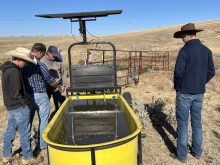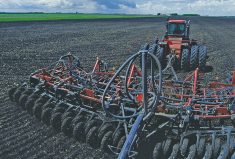Alberta Wheat and Alberta Barley have created a seeding rate calculator that has a significant difference from similar tools — it doesn’t require users to estimate emergence mortality.
“Instead of targeting plants/ft2, this calculator targets seeds/ft2,” the cereal commissions say in an intro for the online tool. “Therefore, emergence mortality is not included in the calculation.”
The calculator (available at albertawheatbarley.com) can be used for six cereal crops: spring wheat, barley (malt and feed), winter wheat, durum, barley silage and solid-stemmed wheat (not durum).
Read Also

Moo translator and methane measures: There’s an app for that
Dalhousie University researchers use artificial intelligence to create new dairy farm apps that analyze cattle sounds and measure methane.
Along with desired seeding rate (ranges are given for those six crops), the germination rate for the seed lot you’ll be using must also be entered into the calculator. Although good-quality seed will have a germination rate of 90 to 99 per cent, it’s recommended those using the calculator enter a specific germination rate provided by a lab. (There’s a link to 28 accredited Canadian seed labs with contact info and the type of work they do. Five are in Alberta.)
The calculator also requires the 1,000 kernel weight (that is, the weight in grams of 1,000 seeds). Again, typical ranges are given but the commissions say it’s important users enter the 1,000 kernel weight for the seed lot being used (which can be obtained from an accredited lab, or the seed grower you purchased the seed from).
Entering those figures yields the number of pounds of seed per acre that will be needed to obtain the desired seeding rate.
An optional feature allows users to enter their row spacing. This produces a calibration figure, expressed in grams of seed per 100 feet of travel.
Alberta Wheat and Alberta Barley have also produced a short video on row spacing in which Jeremy Boychyn, their agronomy research extension specialist, discusses the pros and cons of narrow versus wide spacing.
And there’s a bunch of considerations no matter which way you go, the video points out.
Narrow-row spacing requires more shanks, draft, energy and equipment maintenance, Boychyn notes in the video. Fertilizer toxicity and inter-row competition can also be issues. But it does produce better canopy closure, which reduces weed competition. However, dealing with the crop residue is more challenging, and excess residue will impact emergence and can cause plant stand issues.
On the other hand, wider-row spacing flips the situation on its head. Lower draft, less maintenance on the seed drill, and less residue headaches but more weed issues. Lodging can also be a problem.
The video was shot at a Plot2Farm trial conducted last year (by brothers Wade and Scott McAllister at their farm near Innisfail) comparing 15-inch row spacing to 7.5-inch spacing. The wider spacing produced three fewer bushels per acre but that was worth it considering the operational cost savings, Wade McAllister said in an interview with our sister publication, Grainews, earlier this year.
Alberta’s Ag Ministry has a traditional seeding rate calculator that does require putting in a value for emergence mortality. The provincial calculator can also be used for oats, rye and triticale.
















